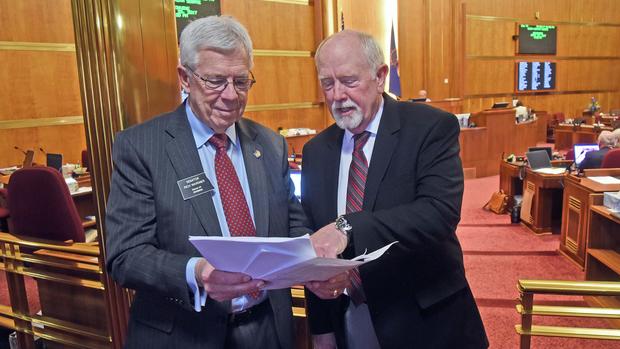Majority Leaders Al Carlson and Rich Wardner: Property Tax Hikes Are Probably the Result of Local, Not State, Budgeting

TOM STROMME/Tribune Senate majority leader Sen. Rich Wardner (R-Dickinson), left, and House majority leader Rep. Al Carlson (R-Fargo) review amendments for legislation before a meeting on Tuesday afternoon in the state capitol.
This guest post was submitted by Senate Majority Leader Rich Wardner (R-Dickinson) and House Majority Leader Al Carlson (R-Fargo).
Property taxes are a hot topic right now, especially in communities where property tax increases are being considered. Without exception, no one likes taxes, especially property taxes. That said, property taxes are necessary to fund local schools, law enforcement, emergency services and infrastructure. It is important to remember that responsibility for determining the appropriate use and rate of property tax rests solely with local voters and elected officials.
As part of that debate, the question has been asked as to what role, if any, the state should play in the assessment, collection and spending of local property taxes? That is a great question. Property taxes are levied and spent by local governments. The state has little, if any, control or oversight of local property taxes, valuations or spending.
Nonetheless, the legislature heard the concerns of property owners across North Dakota and, for over a decade, has been committed to doing all it can to reduce your local property tax burden. In fact, contrary to what you may have read in the media, the legislature once again increased the amount spent on property tax relief in the 2017 session to $1.292 billion.
[mks_pullquote align=”left” width=”300″ size=”24″ bg_color=”#ffffff” txt_color=”#000000″]Property taxes are levied and spent by local governments. The state has little, if any, control or oversight of local property taxes, valuations or spending.[/mks_pullquote]
It all started in 2007. The state legislature passed the very first attempt to help reduce the burden of property taxes. This approach provided an income tax credit equal to 10% of your property tax bill. In 2009, we provided property tax mil levy reduction grants to local school districts. We quickly realized that in the absence of any real control over local spending, tax rates or valuation increases, the state was on an unsustainable course.
So, in 2013, the legislature moved to make property tax relief permanent by incorporating it into the school foundation aid formula and requiring schools to reduce their property taxes by 125 mils. In 2017, we also replaced the 12% property tax buydown with permanent state funding for county social services, which covered up to 20 mils in county property taxes.
What does this mean for property tax payers today?
During the 2015 session, legislators provided $1.241 billion in property tax relief, including $977 million in school tax relief, $241 million to fund a 12% property tax buydown and $23 million to cover the costs of county child welfare and elderly services.
During the 2017 legislative session, legislators provided $1.292 billion in property tax relief, including $1.131 billion in school tax relief, $160 million to cover the costs of county social services and another $23 million for county child welfare and elderly services. In total, we increased state funded local property tax relief by $51 million during the 2017 session compared to the 2015 session.
No gimmicks, no funny numbers, just the facts that show our real commitment to property tax relief, even during difficult times.
But our work did not end there. We also passed property tax reforms including the truth in taxation legislation, which requires local government to notify taxpayers of all local taxes to be assessed and requires property tax statements to clearly show the taxes levied in dollars, not mils.
As local communities and voters evaluate their current property tax assessments, remember that any increase at the local level is likely increase in taxation by your local government and not the effect of state property tax relief reductions. Of course, the effect on individual local taxing entities may vary, but the combined effect should be revenue neutral on your property tax bill.
While painful, we encourage local elected officials to make spending cuts before increasing property taxes. We balanced the state budget without a tax increase and we think our state is better for it.




